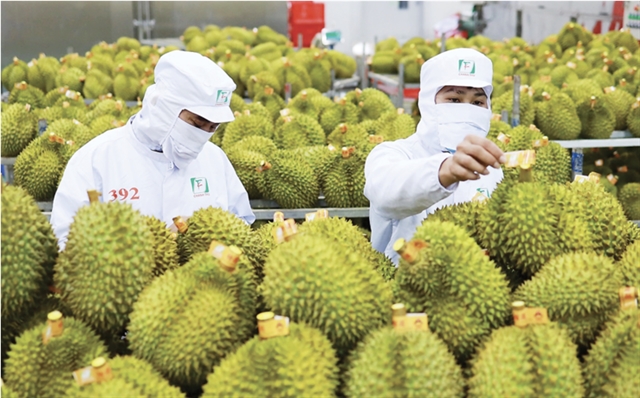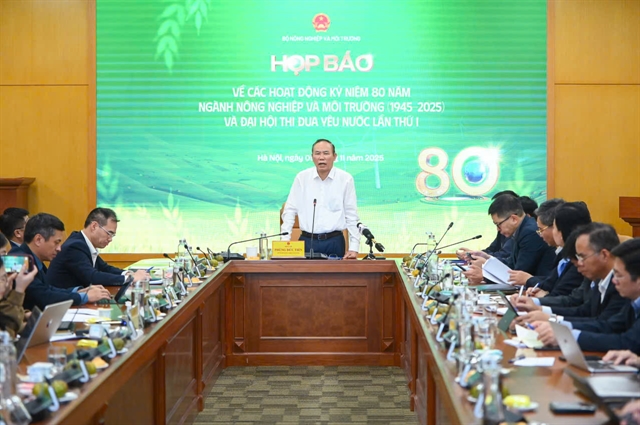 Economy
Economy


|
| Export turnover of durian last year reached $3.2 billion. Photo economy.vn |
HÀ NỘI – Solutions are urgently needed to regain consumer trust in Vietnamese durians and continue developing production sustainably, said General Secretary of the Việt Nam Fruit and Vegetable Association Đặng Phúc Nguyên.
A system for quality supervision from the source must be established and the testing process strengthened at durian production facilities, Nguyên told a seminar on sustainable development in the durian industry held on Tuesday in Hà Nội.
This includes developing food safety and plant quarantine programmes within orchards and packaging facilities by expanding and improving the standardised testing laboratories across durian growing areas to ensure accurate and clear traceability, according to Nguyên.
Expanding and enhancing the capabilities of laboratories will help cover durian growing regions more comprehensively, he noted.
Accurate traceability will help Vietnamese and Chinese authorities identify origin codes, banned residues and other critical data on exported durians.
According to statistics from the General Department of Customs, in the first four months this year, the export value of durian reached US$183 million, a drop of 61 per cent compared to the same period last year.
Durian's sharp decline has dragged down the overall fruit and vegetable sector.
Issues like cadmium residues exceeding permissible limits and the presence of banned substances like auramine O – an industrial dye – should be addressed by establishing supervision systems and plant quarantine protocols directly at the source.
Experts and authorities identify the main cause of cadmium contamination as the accumulation of heavy metals in soil, primarily due to long-term use of chemical fertilisers, especially phosphate-based fertilisers like diammonium phosphate (DAP). Intensive farming focused on yield without input control has inadvertently introduced toxic substances into the supply chain.
In addition to cadmium, Chinese authorities are now tightening inspections for auramine O, which is used to enhance the fruit's yellow colour and stimulate uniform ripening.
This points to major gaps in post-harvest handling and preservation.
In light of the situation's urgency, Nguyên called for strong regulations and penalties against violations related to quality, food safety and commercial fraud. Publicly naming individuals and enterprises in violation of these rules would serve as a deterrent and promote a healthier business environment.
For long-term development, the Việt Nam Fruit and Vegetable Association recommends easing production and export difficulties through zoning concentrated and sustainable cultivation areas, tightening management and issuing of planting area and packaging facility codes, stricter input material control, adjusting cultivation methods and building a national brand.
Chairwoman and CEO of Auto Agri Software Technology JSC Nguyễn Thị Thành Thực said that based on her many years of agricultural business experience, especially in the Chinese market, current standards for toxins like cadmium and auramine O are just some of the technical criteria that markets may impose.
Early preparation is essential, she said.
Thực also emphasised the need for planning sustainable, concentrated growing zones to avoid unregulated expansion, which can result in oversupply.
Proper control and issuance of planting area and packaging facility codes – the 'passport' of Vietnamese durians – are crucial.
Localities must increase both scheduled and surprise inspections to ensure compliance with assigned codes, she noted.
Thực said: “We hope the provinces of the Central Highlands will have a biotechnology centre to address the root challenges of Vietnamese agriculture, and invest in post-harvest processing technology.”
According to the Đắk Lắk Durian Association and Auto Agri, a major shortfall remains in key farming areas, with a lack of wholesale markets, inspection and quarantine centres, and on-site import-export procedures.
The two main agencies with control over export 'visas' are customs and the Plant Protection Department, which manages planting area codes.
Currently, planting area codes are not properly managed or authorised. There have been cases of code misuse, with one code being applied to multiple locations, making regulation difficult.
Thực urged farmers to protect their assigned codes to avoid unnecessary risks.
From the Government’s perspective, Nguyễn Quang Hiếu, deputy director of the Department of Crop Production and Plant Protection, said that after the export protocol with China was signed, Việt Nam’s durian exports surged.
The value exceeded $2 billion and $3.2 billion in 2023 and 2024, respectively, accounting for 45–47 per cent of total fruit and vegetable exports.
Faced with this overheating growth, the ministry held a major conference to raise awareness of emerging risks.
Regarding cadmium residue warnings from China, Hiếu said that Việt Nam received the first alert in March 2024. His department conducted investigations and found some regions with high cadmium levels.
Hiếu noted that cadmium contamination stems from both natural factors, such as soil composition, and human factors like excessive fertiliser use without allowing the land to rest.
As for auramine O, he explained that China introduced new rules after detecting the substance in Thai durians.
It is typically used post-harvest.
To prevent risks, China now applies these rules to all exporters, including Việt Nam.
He also mentioned that the Department of Crop Production and Plant Protection is assisting farmers in dealing with cadmium-contaminated soil, though this will take time.
Deputy Director of the Department of Quality, Processing and Market Development Phan Văn Duy said that Việt Nam currently has 34 certified cadmium testing facilities and 19 for auramine O, of which 24 cadmium and 15 auramine O labs are recognised by China.
However, four labs were delisted by Chinese authorities due to discrepancies between test results in Việt Nam and those upon arrival in China.
This discrepancy is a real risk, partly because testing is based on representative samples while actual farming areas are vast, making absolute compliance difficult.
He urged localities and agencies to coordinate more closely, especially in early-stage production monitoring.
The Ministry of Agriculture and Environment has issued food safety programmes for agricultural supply chains, including durian.
To sustain the industry, they aim not only to boost production, but also to build a robust food safety control system across the value chain.
The ministry is drafting and consulting on a Food Safety Control Process for durian products, taking input from departments including Plant Protection, Crop Production, the Department of Science and Technology and agriculture departments in key provinces like Tiền Giang, Đắk Lắk, Đồng Nai and Đắk Nông.
They have also gathered feedback from major durian exporters, most of whom support the initiative.
In addition, the ministry is reviewing and updating National Standard TCVN 10739:2015 for fresh durian first issued in 2015.
The revision aims to align technical requirements with international practices, enabling Vietnamese durians to meet standards not only in China but also in high-end markets like Japan, South Korea and the EU, which demand strict food safety compliance. VNS




